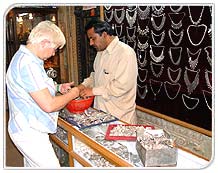 The
builders of Jaipur took special care to provide ample space and facilities for
the production and marketing of hadicarfts which made the place famous throughout
India and abroad. An entire street and several city sectors were earmarked for
artisans and traders. The mainmarkets are along Jauhari Bazar, Bapu Bazar, Nehru
Bazar, Chaura Rasta, Tripolia Bazar and M.I. Raod.
The
builders of Jaipur took special care to provide ample space and facilities for
the production and marketing of hadicarfts which made the place famous throughout
India and abroad. An entire street and several city sectors were earmarked for
artisans and traders. The mainmarkets are along Jauhari Bazar, Bapu Bazar, Nehru
Bazar, Chaura Rasta, Tripolia Bazar and M.I. Raod.